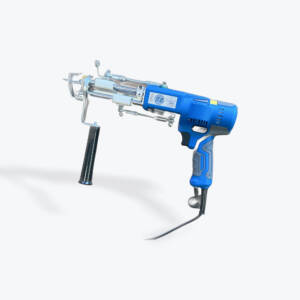As with any new skill, the first time you dive into a new craft can feel a little overwhelming. Knowing what to expect during your first tufting session will help you feel more confident and prepared for the creative journey ahead.
In this blog, we’ll walk you through what you can expect in your very first tufting session, from setting up your workspace to finishing your first design. Ready? Let’s get started!
Setting Up Your Tufting Space
Prepare Your Workspace
Creating a comfortable, organized workspace is essential to getting the most out of your tufting session. Make sure you have enough room to move around and set up your tufting frame comfortably.
A spacious table or sturdy surface is ideal. Good lighting is also crucial so you can see your work clearly and avoid unnecessary strain on your eyes.
Keep in mind that tufting involves some repetitive movements, so choose a spot that allows you to sit or stand comfortably for extended periods of time. A chair with good back support or an adjustable height table is ideal.
Related: Beginners’ tufting guide
Gathering Materials
Before you start tufting, gather all the necessary materials. You’ll need:
- A tufting gun (cut pile or loop pile, depending on your choice).
- Backing fabric (monk’s cloth or burlap is commonly used).
- Tufting frame to hold the fabric taut.
- Yarn (acrylic or wool, depending on your project).
- Scissors or clippers for trimming the yarn.
Having everything in place ensures a smooth start, and you won’t be scrambling for supplies in the middle of your session. It would be great if you bought a starter kit that comes with all the essential materials.
Getting Familiar with the Tufting Gun
How the Tufting Gun Works
The tufting gun is the primary tool you’ll use to punch yarn through the backing fabric to create the loops that make up your rug. There are two main types of tufting guns:
- Cut pile tufting guns: These cut the yarn loops as they are inserted, creating a soft, plush texture.
- Loop pile tufting guns: These leave the loops uncut, giving your rug a more textured, traditional look.
In your first session, you’ll likely use a cut pile tufting gun, as it’s easier to manage for beginners. If you’re unsure about how the gun works, take a few moments to test it out before starting your actual project.

Testing the Gun
Before diving into your design, it’s a good idea to practice using the tufting gun on a scrap piece of fabric. This helps you get comfortable with the gun’s weight, speed, and how it feels to pull the trigger. Adjust the speed and pressure to find a setting that feels most comfortable for you.
Starting Your First Design
Transferring Your Design
Once you’re familiar with the tufting gun, it’s time to bring your design to life. Start by transferring your design onto the backing fabric. For beginners, it’s easiest to start with a simple design. You can either draw directly on the fabric with a fabric pen or use carbon paper to trace your design.
Take your time with this step, as your design will guide your tufting process. Accuracy here will make the tufting process smoother.
Tufting Your First Loop
Now comes the fun part! It’s time to tuft your first loop. Here’s a simple breakdown:
- Position the tufting gun’s nozzle over your design.
- Gently pull the trigger to start feeding the yarn through the backing fabric. You’ll notice loops starting to form as the yarn is pushed through the fabric.
- Keep the gun moving smoothly along the design, trying to maintain consistent tension in the yarn.
As you work, make sure to move at a steady pace. If you go too fast, the loops will be shallow. If you move too slowly, the loops might become too dense.
Common Challenges and How to Overcome Them
Uneven Loops or Tension
One of the most common challenges when tufting is maintaining consistent loop height and tension. Uneven loops can happen if you’re not keeping the yarn tight enough or if the tufting gun is moving inconsistently.
How to overcome it:
- Keep the yarn flowing smoothly through the tufting gun.
- Move the gun in steady, fluid motions, ensuring even pressure.
Don’t hesitate to slow down if you notice any unevenness.
Fixing Mistakes
If you notice a mistake, such as an uneven area or a missed section, it’s easy to fix. Simply pull the yarn back out and re-tuft the section, starting fresh. It might take a bit of practice, but don’t be discouraged. Mistakes are part of the learning process!
Taking Breaks and Staying Comfortable
Avoiding Fatigue
Tufting can be physically demanding, especially for beginners. It’s important to take regular breaks to avoid fatigue or strain. Step away from your work every 20-30 minutes to stretch and give your hands a rest. This helps keep you energized and focused throughout the session.
For more hands-on learning, we offer tufting workshops with expert guidance to help you improve your skills.
Comfortable Posture
Good posture is key to staying comfortable while tufting. Try to maintain a neutral, relaxed position, whether sitting or standing. If you’re working for extended periods, consider using a supportive chair or a standing desk. Keeping your back and neck aligned will help prevent any aches or pains later on.
Completing Your Session
Finishing Your First Section
Once you’ve completed a section of your design, step back and assess your work. Don’t worry if it’s not perfect – the goal here is to learn and improve. As you move on to the next section, make any adjustments to your technique to ensure a more consistent outcome.
Cleaning Up
When you’re finished with your first tufting session, make sure to clean your tools properly. Store the yarn in a dry, cool place, and always clean the tufting gun according to the manufacturer’s instructions. Proper cleaning and storage will extend the lifespan of your tools and help you stay organized for your next session.
What’s Next After Your First Tufting Session?
Reviewing Your Work
After your first session, take a moment to admire your rug. Whether it’s perfect or a bit rough around the edges, it’s a great start. Reflect on what worked well and where you can improve next time. This is the beauty of tufting—each session will improve your skills and help you create even more intricate and professional-looking rugs.
Future Projects
With your first session under your belt, you’re now ready to take on more complex designs. Try working on larger rugs, experimenting with different yarn textures, or even adding additional tufting techniques like shading and patterns. The possibilities are endless!
Conclusion
Your first tufting session is an exciting learning experience. Don’t stress about making it perfect – just enjoy the process and embrace the opportunity to experiment. With each session, you’ll grow more comfortable with the tufting gun and develop your unique creative style.
So, gather your materials, set up your space, and dive into your first tufting session. It’s the beginning of a fun and rewarding crafting journey!








